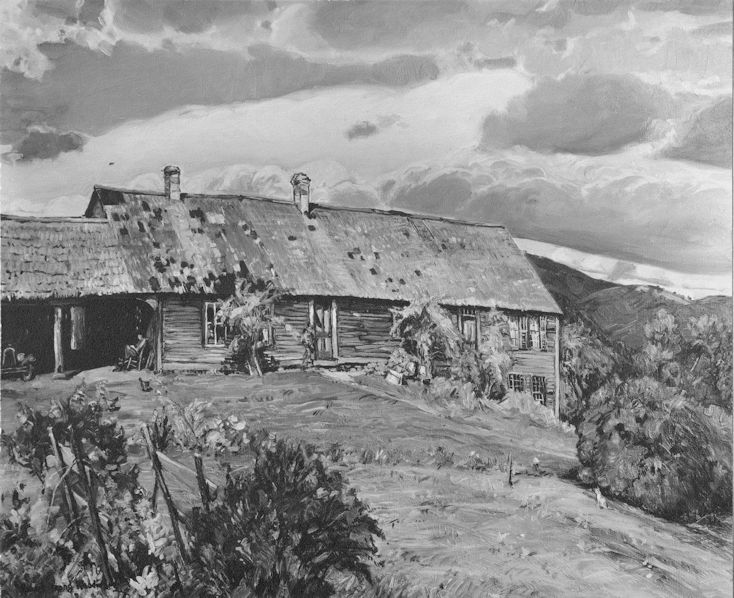Quick Reference
Painted in summer 1933.
Between Halifax, VT and Colrain,
MA. "Elm Grove" is an area of
North Colrain on MA112 just
before Vermont line...
Oil on Canvas
Landscape
Houses
30" x 36"
Boston Art Club, 1933
Jones Library, Amherst Coll., 1934
Hotel Weldon,(Greenfield, MA) 1934
Concord Art Association, 1934
Binghamton Museum of FA, 1934
Westfield Athenaeum, 1934
MacBeth Galleries, NYC, 1935
Southern Vermont AA, 1935
Deerfield Academy, 1935
Dwight Memorial, Mt. Holyoke
College, 1935
Pennsylvania Academy of FA, 1936
Vose Galleries, Boston, 1936
Jasper Rand Art Gallery,
Chicago, 1936
Art Institute of Chicago, 1937
MacBeth Galleries, NYC, 1938
Jones Library, Amherst Coll., 1938
MacBeth Galleries, NYC, 1939
Gardner (MA) Town Hall, 1940
Rhode Island School of Design,
date Unknown
N/A
Featured Artwork: Passing New England
RSW's Diary Comments

 Robert Frost in 1957
Robert Frost in 1957
"Painted in summer 1933. Most picturesque old New England house near Vermont line between Halifax and Colrain (above Elm Grove), A much traveled and lauded canvas, invited out to the Art Institute in Chicago, etc. One of my outstanding paintings I am certain. In the winter of 1940-1 Robert Frost, the poet, moved to Cambridge and wrote he wished to exchange the canvas he had purchased in 1932 Winter Dignity (which see) because of reasons of sentiment etc. due to the death of his wife and son, so this Passing New England along with many others, I sent down to the Vose Galleries for Mr. Frost to see. Among them he chose this Passing New England. So it is now owned by our most noted poet, Robert Frost."
Comments on the back of a sepia print:
"My most powerful record of passing New England. A popular picture among museums and galleries, was invited to the Rhode Island School of Design, the recent annual at Pennsylvania Academy, Philadelphia, and has just been invited by Mr. Harshe to annual exhibition in October at the Art Institute of Chicago. This canvas is now owned by Robert Frost."
Comments in a notebook by RSW:
"June 19th, 1936: Packed in a crate and sent to Macbeth Galleries, 11 East Street, New York, (through W. S. Budworth the packers at 424 East 52nd Street: Passing New England 30" x 36"."
From the back a of matted photograph of the painting:
"This painting is not for sale. It is the one, among many of my canvases, which was chosen, and is owned by our poet Robert Frost. I thought it might interest you to see what our great poet - a friend of mine - chose." [We do not know who was the intended reader...]
Additional Notes
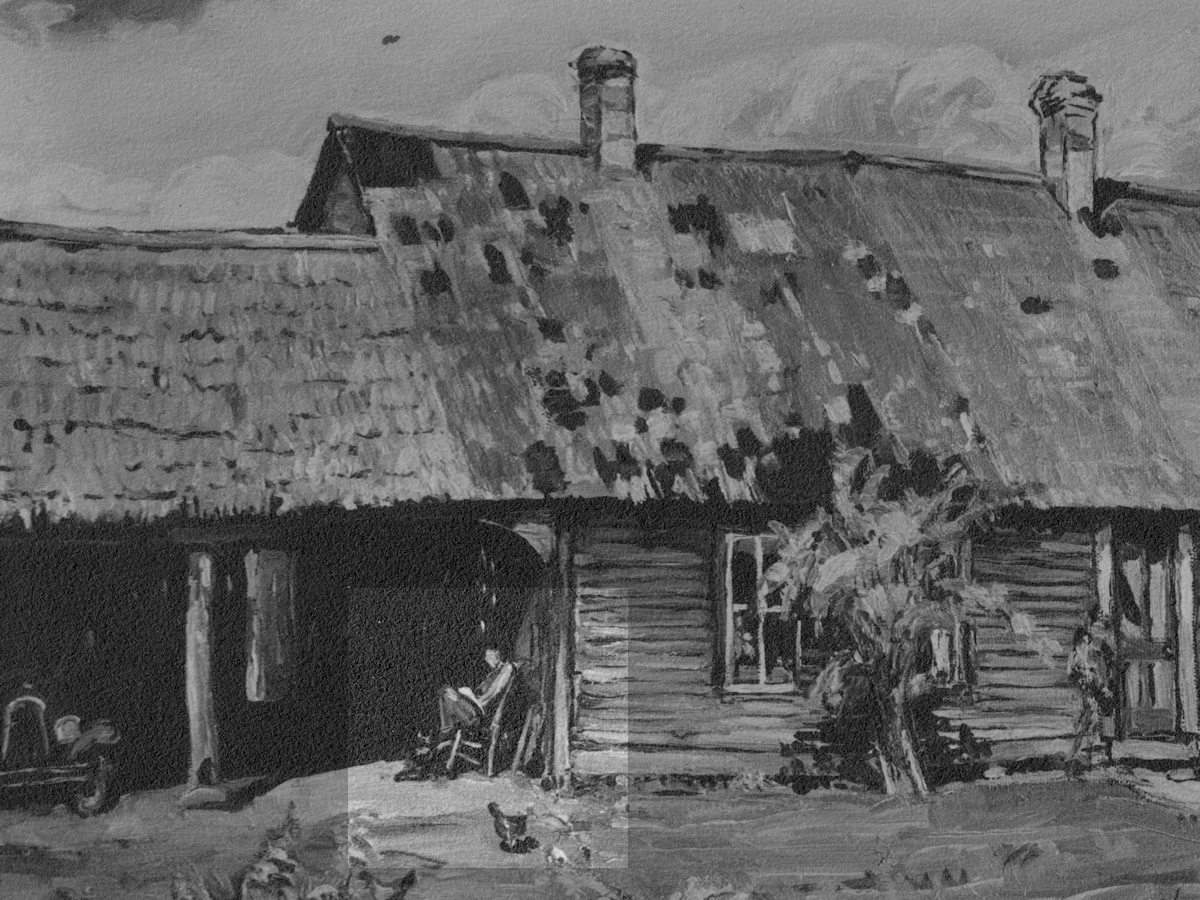
 A closer look at the man sitting in a chair that
A closer look at the man sitting in a chair that
appears to be kicked back and leaning against the wall.
Note the chickens and a rare glimpse of an automobile!
The paintings of "home" in this period featured men
"retreating" to some comfort of rest or leisure. A sense
of calm during the height of the depression also featured
in A Country Piazza... A commentary of sorts?
It is the height of the depression and Woodward's career as a landscape artist. The American Art Scene Painting movement is really gaining momentum and Woodward is painting a series of powerful depictions of New England homes and people with a very decerning commentary. He starts painting the series in 1929, starting with A Country Piazza, then Genial Old House, and in 1933 he paints this painting, as well as, Contentment. Two of these paintings reside in museums and this painting eventually in the hands of poet Robert Frost.
There is also a cultural war going on in country between the prominent regions of the nation - New England, the Midwest, the Mid-Atlantic, the South and the West Coast. Many of the regions are rebelling against New England's dominant influence on art and culture with the Midwest winning out as now carrying the mantle of the American Ethic. Only, the work being celebrated as reflecting this ethic is what is called "Social Realism."
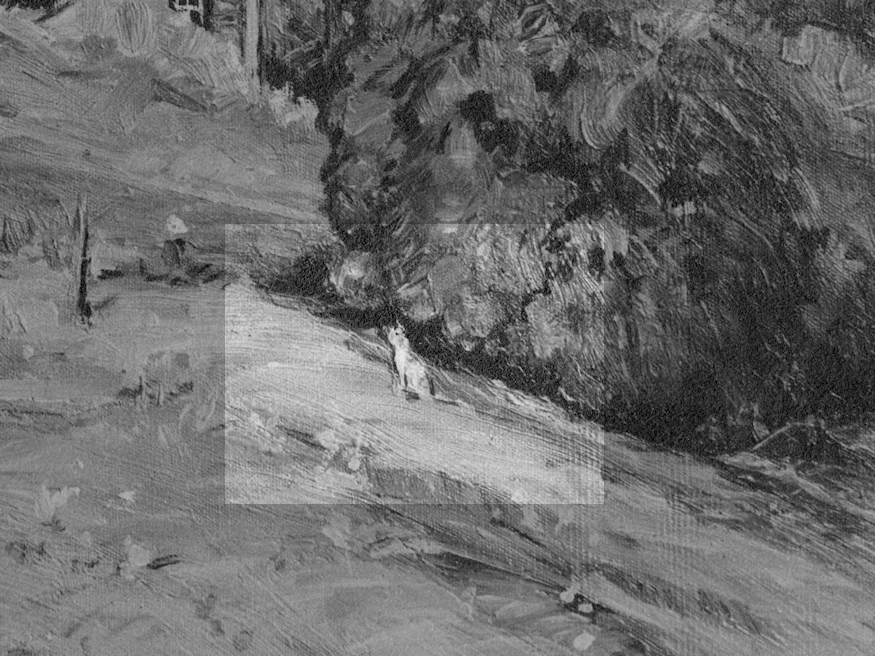
 Here is a closer look at the cat sitting by a bush
Here is a closer look at the cat sitting by a bush
in the lower right of the painting. RSW featured pets,
particularly cats, in a number of paintings [see Genial
Old House]. He would featured a dog, also in 1933, in
the painting Contentment, as well as House in Halifax
in 1936. Contentment is a title of note. It conveys the
same idea of calm and peace during difficult times.
Look at the house above 7 years into the depression.
Social Realism's focus is primarily centered on the people and their portrayals. It is very exaggerated and embellished perspective. Woodward, who grew up in the Midwest, did not care for the liking of such exaggerations. Woodward was the master of the understated yet powerful message of the simple, ordinary and thus dignified nature of life. In this sense he was counter-culture to the popular movements of his day. The nation is in a panic. It is chaos and RSW is seeming to be saying, "stay calm and carry on..." just as Winston Churchill would tell his people during the Battle of Britain in WWII.
This is why Robert Harshe's involvement with this painting and A Country Piazza is so important. Harshe is the director of the Art Institute of Chicago and quite possibly one of the most important art influencers of the time. Harshe would personally invite both paintings to exhibitions he curated. The 1933 Chicago World's Fair exhibition is often cited as his crowning achievement, for which RSW was reportedly the only New England artist invited.
A personal plea from the founder of this web site:
Robert Frost was a contemporary and close friend of artist Robert Strong Woodward and
owned at least three of his paintings. Critics of the day frequently compared these two men as artists of words and print. Frost
owned an oil painting during his professorship at Amherst College which was called Winter Dignity. When his wife died he wrote
to Mr. Woodward that she had so loved the painting that he would like to exchange it...it saddened him too much to view it. This
was done. I personally drove to Amherst to pick up the painting and later drove three other paintings to the Vose Gallery in Boston
for Mr. Frost to make a choice. He had by then had given up his professorship at Amherst, and moved to Cambridge. The painting he
selected was Passing New England.
I am now searching for the whereabouts of this painting, hoping to at least obtain a digital color image of it for my web site.
All I have at present is the sepia print illustrated above. Do you, my reader, have any information about this painting? Perhaps
you could refer me to a descendent of Mr. Frost who may know what might have happened to it. I would very much appreciate it if
you contact me (email link below) with any information you might have.
Thank you.
Mark Purinton, Founder ![]()
✽ Dr. Mark passed in 2020 but our interest in this painting
remains the same. Contact Larch or Brian.

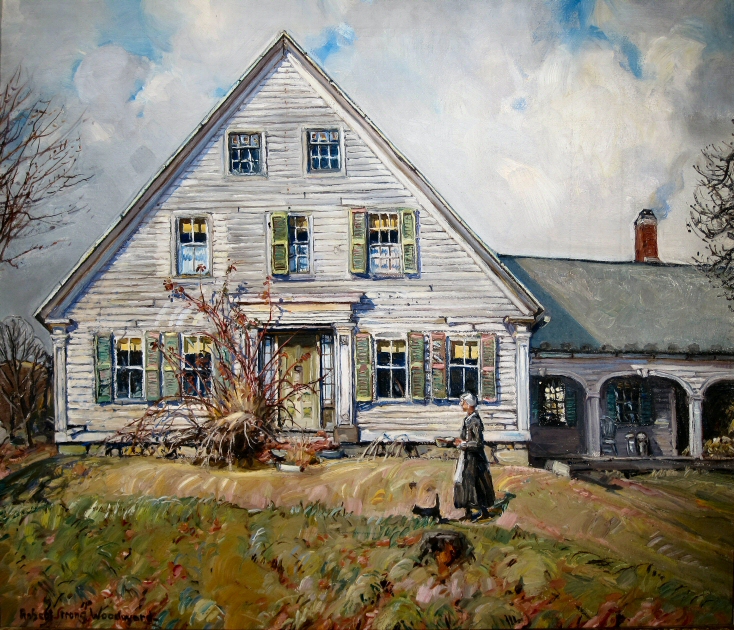
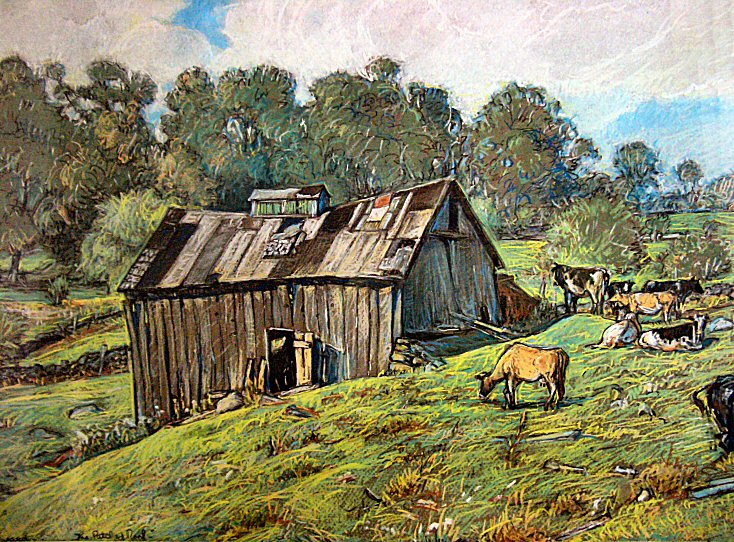

.png)

